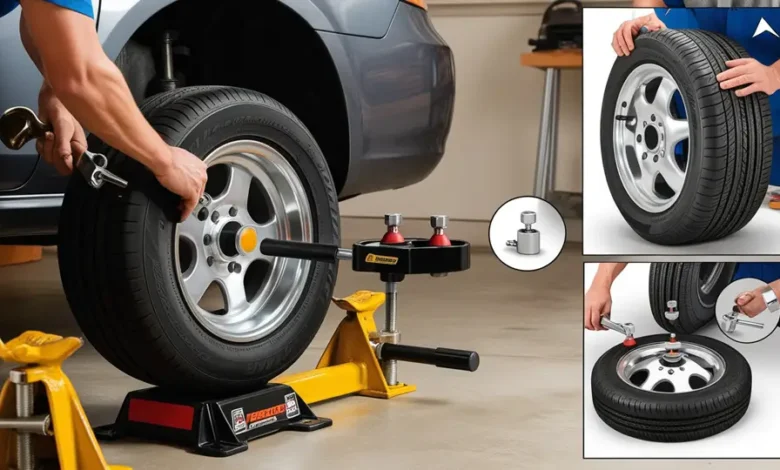
Introduction
Engaging Opening Line:
Balanced tires are essential for ensuring a smooth ride, enhancing safety, and maintaining the overall performance of your vehicle. Whether you’re cruising down the highway or navigating city streets, properly balanced tires help keep your vehicle stable and your driving experience comfortable.
Why Tire Balancing Matters:
Tire balancing ensures that the weight of your tires is evenly distributed around the axle, preventing unnecessary vibrations, reducing uneven wear, and optimizing fuel efficiency. By balancing your tires, you not only prolong their lifespan but also improve the handling and overall performance of your vehicle.
Discover how balancing your tires at home can enhance your driving experience and save you money.
Importance of DIY Tire Balancing:
One of the greatest advantages of DIY tire balancing is the cost savings. Professional tire balancing services can be expensive, especially if done frequently. By learning how to balance your own tires, you save money, gain the convenience of doing it at home, and maintain your vehicle’s health by ensuring tires are always in optimal condition.

What is Tire Balancing?
Definition and Purpose:
Tire balancing is the process of equalizing the weight of the tire and wheel assembly so that it spins smoothly at high speeds. This is achieved by adjusting the weight distribution across the tire to ensure that no one section of the tire is heavier than the other. Proper tire balancing is essential for ensuring a smooth ride, reducing vibrations, and maintaining even tire wear, leading to better vehicle performance and longevity.
Impact of Unbalanced Tires:
Unbalanced tires can lead to a range of issues that affect both your driving experience and the health of your vehicle. When tires are unbalanced, you may notice vibrations in the steering wheel, floorboards, or seats, especially at higher speeds. Over time, this can cause uneven tire wear, which reduces the lifespan of your tires. Additionally, unbalanced tires can negatively impact fuel efficiency, as the engine has to work harder to overcome the extra friction and drag.
Common Signs of Tire Imbalance:
- Vibrations: One of the most noticeable signs of unbalanced tires is a vibration in the steering wheel, particularly when driving at higher speeds.
- Uneven Wear: If you notice that your tires are wearing unevenly—such as more wear on one side than the other—it could indicate an imbalance.
- Steering Issues: Difficulty in steering or pulling to one side can also signal a problem with tire balance.
Essential Tools You’ll Need for DIY Tire Balancing
Basic Tools Required:
To successfully balance your tires at home, you’ll need some basic tools that are easily accessible:
- Lug Wrench: Used to remove and tighten the lug nuts on your tires.
- Jack: To safely lift your car and remove the wheels.
- Tire Weights: These are used to correct imbalances by adding weight where needed.
- Cleaning Supplies: A brush or cloth to clean the wheels before balancing them.
Optional Equipment:
While it’s possible to balance tires manually, having a balancing tool can make the job easier and more accurate. Here are a few optional items you might consider:
Learn the essential tools and steps for effective DIY tire balancing, ensuring a smoother and safer ride.
- DIY Tire Balancer or Bubble Balancer: These are affordable, easy-to-use tools that help you identify where the weight needs to be added to balance the tire properly.
- Torque Wrench: Useful for ensuring that lug nuts are tightened to the manufacturer’s specifications.
By having the right tools on hand, you’ll be able to balance your tires safely and efficiently.
Step-by-Step Guide to Balancing Tires at Home
Prepping the Car and Tires:
- Jack Up the Car and Remove the Tires: Use a jack to lift your car off the ground and a lug wrench to carefully remove the tires.
- Clean the Tires and Wheels: Before starting, make sure the tires and wheels are free of dirt, debris, or any old balancing weights. This will help ensure accuracy in the balancing process.
Using a DIY Tire Balancer:
- Mount the Tire on the Balancer: Place the tire on the bubble balancer or any DIY tire balancing device. Make sure it’s positioned correctly and securely.
- Check for Imbalance: Observe the tire to see which side is heavier. The side that dips down indicates where the imbalance is.
- Add Weights: Place small tire weights on the lighter side of the wheel until the tire sits level on the balancer.
- Recheck the Balance: After adding weights, double-check to ensure the tire is properly balanced. Adjust as necessary until the tire is perfectly level.

Manual Tire Balancing (Without a Machine):
- Spin and Observe: Once the tire is mounted back onto the car, spin it manually and look for any visible wobble.
- Mark the Heavy Spot: Use chalk or a marker to indicate the part of the tire that seems to be out of balance.
- Add Weights: Begin by adding weights opposite the heavy spot. Keep testing and adjusting until the tire spins smoothly without wobbling.
By following these steps, you’ll be able to balance your tires at home effectively and safely.
Common Mistakes to Avoid When Balancing Tires
Improper Weight Placement:
One of the most frequent mistakes is placing the tire weights incorrectly. Weights must be positioned precisely where the imbalance occurs. Placing them even slightly off can result in continued vibrations and uneven wear. Always double-check the balance after adding weights to ensure accuracy.
Skipping Tire Cleaning:
Dirt, debris, or old tire weights can interfere with the balancing process. Failing to clean the tires and rims before balancing can cause inaccurate readings and lead to poor results. Ensure the wheel surface is clean and free from buildup before starting.
Not Checking Tire Pressure:
Balancing tires with improper tire pressure can give false results. Make sure all tires are properly inflated to the recommended pressure levels before attempting to balance them. Incorrect pressure can mimic the symptoms of imbalance and affect the quality of your work.
Avoiding these common mistakes will ensure that your tire balancing efforts are successful and your ride is as smooth as possible.
Benefits of DIY Tire Balancing
Cost Savings:
One of the most significant advantages of DIY tire balancing is the money you save. Professional tire balancing services can add up, especially when done regularly. By balancing your tires at home, you avoid these recurring expenses, making it a cost-effective solution over time.
Convenience:
Balancing your tires at home offers convenience. You can perform the task whenever it’s needed without having to schedule an appointment or visit a shop. This is particularly useful if you notice signs of imbalance during a road trip or at a time when auto shops are closed.
Prolongs Tire Life:
Regularly balancing your tires helps prevent uneven wear, extending the life of your tires. This means fewer replacements and more miles out of each set, further contributing to long-term savings.
Improved Vehicle Performance:
Properly balanced tires improve handling, reduce vibrations, and create a smoother driving experience. DIY balancing helps maintain your vehicle’s performance, ensuring optimal comfort and safety on the road.
When to Seek Professional Help
Situations That Require Professional Balancing:
While DIY tire balancing can be effective for many issues, there are situations where professional help is essential:
- Persistent Vibration: If you’ve balanced your tires at home but still experience vibrations or handling issues, it’s time to consult a professional. Persistent problems might indicate other underlying issues that require expert diagnosis.
- High-Speed Instability: For issues that arise at high speeds, professional balancing techniques might be needed to ensure precision and safety.
- Complex Tire Problems: If your tires show signs of damage, uneven wear, or if you’ve recently had a major repair that could affect alignment, professional assessment is recommended.
Advanced Balancing Techniques:
Some balancing methods go beyond basic DIY techniques and involve specialized equipment:
- Road Force Balancing: This technique simulates the forces that tires experience on the road by applying pressure through a large roller. It’s highly effective for detecting issues that might not be apparent with standard balancing methods. Road force balancing helps to identify and correct issues related to tire conicity and sidewall stiffness.
- Dynamic Balancing: Dynamic balancing involves spinning the tire and wheel assembly on a machine to assess balance while in motion. This method is precise and is typically used for high-speed balancing, offering a more accurate result than static methods.
Seeking professional help ensures that your tire balancing is done with the most accurate and advanced techniques, providing you with a smoother and safer driving experience.
Final Tips for Success
Routine Tire Maintenance:
- Regular Checks: To keep your vehicle in top condition, make it a habit to check your tire balance and overall health regularly. Aim to inspect your tires every 6,000 to 8,000 miles or as recommended by your vehicle manufacturer.
Avoid common mistakes and keep your tires in top shape with our expert tips for at-home balancing.
- Balance Intervals: Schedule tire balancing whenever you have new tires installed, after hitting a pothole or curb, or if you notice any changes in driving performance. Regular balancing helps prevent issues before they become significant problems.
- Tire Rotation: Along with balancing, regular tire rotation helps ensure even wear across all tires, extending their lifespan and maintaining vehicle performance.
Monitoring for Imbalances:
- Watch for Symptoms: Be vigilant for signs of imbalance such as steering wheel vibrations, uneven tire wear, or changes in handling. Address these issues promptly to avoid further complications.
- Listen to Your Vehicle: Pay attention to any unusual noises or vibrations while driving. These can be early indicators of tire imbalance or other related issues.
- Use Visual Inspections: Regularly inspect your tires for visible signs of imbalance or damage, such as bulges or uneven tread wear. Early detection can prevent more severe problems and ensure your vehicle’s safety.
By following these tips and maintaining regular tire checks, you’ll ensure a smoother, safer ride and prolong the life of your tires.
Recap the Key Points:
Balancing your tires at home is a straightforward task when you have the right tools and follow the correct steps. From using basic equipment like a lug wrench and a jack to more specialized DIY balancers, the process is manageable and can save you both time and money. Regular tire balancing not only improves your vehicle’s performance but also extends the life of your tires.
Encouragement:
Don’t be intimidated by the idea of DIY tire balancing. With a little practice and the right tools, you can easily balance your tires at home, enjoying the satisfaction of a job well done and the financial benefits that come with it. Embrace the opportunity to maintain your vehicle efficiently and cost-effectively.
Have you tried balancing your tires at home? Share your experiences or any tips. If you have any questions or need further assistance, feel free to ask. Your feedback can help others and contribute to our community of automotive enthusiasts.




